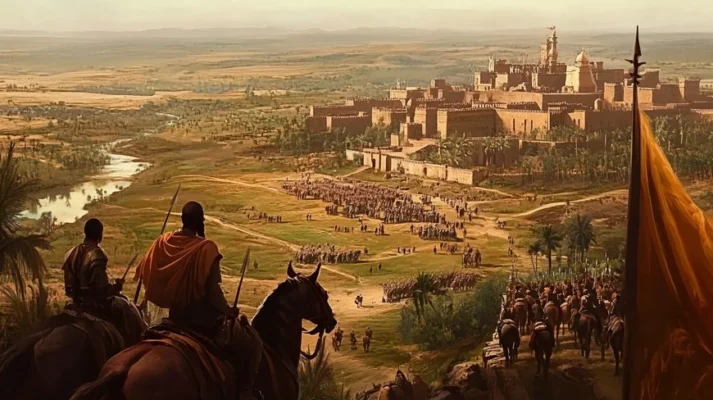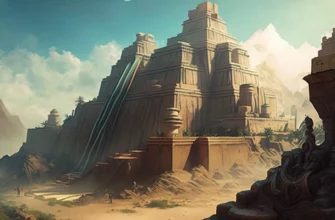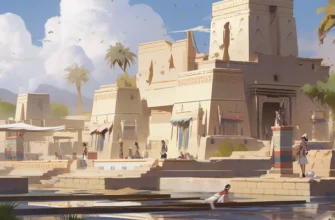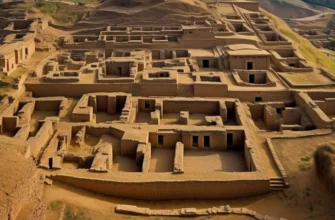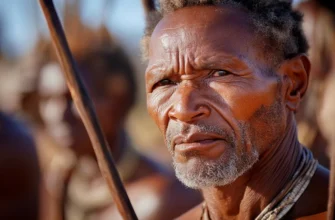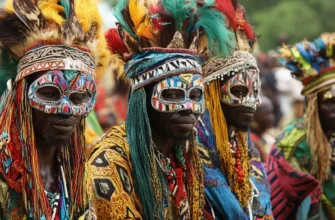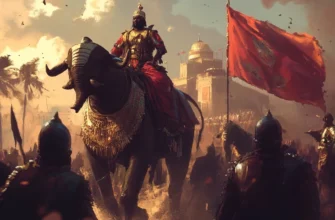The Songhai Empire was one of the greatest states in West Africa, reaching its peak in the 15th–16th centuries. It was formed on the territory of modern Mali, Niger, and Nigeria, inheriting the greatness and trade routes of the fallen Mali Empire.
Songhai became powerful thanks to its favourable location along the Niger River, which facilitated trade in gold, salt and slaves. The most famous ruler, Sonni Ali (1464–1492), expanded the territory of the state and created a strong army.
His successor, Askia Mohammed (1493–1528), reformed the administration, strengthened Islam, and turned Timbuktu into a center of science and culture. After Askia Mohammed’s death, the empire gradually weakened due to internal conflicts and power struggles.
In 1591, the Moroccan army, armed with firearms, inflicted a crushing defeat on Songhai at the Battle of Tondibi. This led to the collapse of the empire and the loss of its greatness.
Despite its decline, the Songhai Empire left a significant cultural and historical mark. Its contribution to trade, Islamic education, and public administration is still felt today in West African countries.
- The origins and formation of Songhai
- Early settlements and the formation of statehood
- The role of the Niger River in the development of Songhai
- The rise under Sonni Ali
- The Golden Age of the Empire
- The reign of Askia Mohammed
- Administrative and military system
- Development of trade and economy
- Infrastructure and financial system
- Trading cities and economic centers
- Economic ties
- The spread of Islam and the influence of religion
- The political influence of Islam
- Education and centers of science (Timbuktu and Djenné)
- Architectural monuments
- Art, architecture, and traditions
- Holidays and religious rituals
- Decline and fall of the empire
- The collapse of the empire
- The legacy of the Songhai Empire
- Economic legacy
- Conclusion
The origins and formation of Songhai
The Songhai Empire has deep roots dating back to ancient times when the first Songhai settlements appeared on the banks of the Niger River. The favorable geographical location contributed to the development of agriculture, fishing, and trade, which gradually transformed small communities into a powerful state.
In the 9th–11th centuries, the city of Gao became an important trading center, attracting merchants from North Africa, the Middle East, and Sudan. The Songhai were initially under the influence of the Ghana Empire and later Mali, but by the 14th century, they had begun to strengthen their independence. In the mid-15th century, during the reign of Sonni Ali, the state finally broke away from Mali and became a powerful empire. He initiated expansion, conquering neighboring territories and laying the foundation for the future greatness of Songhai.
Early settlements and the formation of statehood
The first settlements of the Songhai people appeared on the banks of the Niger River in ancient times, when local tribes began to cultivate fertile lands for agriculture, fishing, and cattle breeding. Thanks to the river routes, they actively traded with neighbouring peoples, which contributed to the development of the economy and social structure.
Over time, small communities united around the city of Gao, which became an important trading centre. In the 9th–11th centuries, the first elements of statehood began to form here, when the Songhai rulers established control over the caravan routes and consolidated their power. The influence of Islamic merchants from North Africa contributed to the introduction of administrative reforms and political centralization.
For centuries, Songhai was under the influence of the powerful empires of Ghana and Mali, but by the 14th century, it began to strengthen its independence. The strengthening of military organization and control over strategic trade routes contributed to the transformation of Songhai into a powerful force that paved the way for the creation of a great empire.
The role of the Niger River in the development of Songhai
The Niger River played a key role in the formation and development of the Songhai Empire, ensuring its economic, social, and political growth. As the main waterway in the region, it facilitated the development of agriculture, as the fertile soils along its banks allowed for the cultivation of important crops such as millet, sorghum, and rice. In addition, the river was a major source of fish, providing the population with food resources.
The Niger was also a vital trade route connecting the cities of the empire with remote regions. Thanks to water transport, the Songhai were able to effectively control trade flows between North and West Africa, including the trade in gold, salt, and slaves. The main city of Gao, located on the river, became a strategic economic and political center.
In addition to its economic importance, the Niger River played an important role in military affairs, as it allowed for the rapid movement of troops and the supply of provisions. Control over the Niger was one of the factors that ensured Songhai’s power and long reign in the region.
The rise under Sonni Ali
The rise of the Songhai Empire began during the reign of Sonni Ali, who ruled the state from 1464 to 1492. He became the first great conqueror of Songhai, strengthened its independence, and expanded its territory, turning the state into a dominant power in West Africa.
Sonni Ali began his reign with military reforms, creating a powerful army and navy that allowed him to effectively control the Niger River and coastal cities. His troops used quick maneuvers and lightning attacks, which helped him conquer key trading centers, including the famous Timbuktu and the city of Jenneh. This strengthened the empire’s economic power, as both cities were important hubs for trans-Saharan trade.
Unlike previous rulers, Sonni Ali did not limit himself to military conquests. He introduced a system of administrative control that allowed him to maintain control over the new territories. However, his reign was also marked by cruelty, especially towards Muslim scholars and merchants who opposed his authoritarian methods.
Thanks to successful military campaigns and strategic control over trade routes, Sonni Ali laid the foundation for the further prosperity of Songhai. After his death, the empire continued to grow, especially during the reign of Askia Mohammed, who completed the process of state formation and made Islam an important factor in political life.
The Golden Age of the Empire
The Golden Age of the Songhai Empire came during the reign of Askia Mohammed (1493–1528), who transformed the state into the most powerful force in West Africa. He introduced an effective administrative system, expanded the territory, and strengthened the economy, trade, and culture.
Askia Mohammed reformed the administration by dividing the empire into provinces, each with its own governor. He also created a developed tax system that ensured stability and prosperity. His reign was characterized by active support for Islam: he invited scholars, built mosques, and developed education. Timbuktu and Djenné became leading centers of science, where renowned Islamic theologians and scholars worked.
The empire’s economy flourished thanks to its control over trans-Saharan trade. The Songhai monopolized the supply of gold, salt, slaves, and goods passing through their territory. Trading cities such as Gao, Timbuktu, and Djenné became rich and influential.
During the reign of Askia Mohammed, the empire reached its peak, but after his removal from power, a gradual decline began. Internal conflicts and power struggles weakened Songhai, eventually leading to its downfall after the Moroccan invasion in 1591. Despite this, the empire’s legacy left a deep mark on the history of West Africa.
The reign of Askia Mohammed
The reign of Askia Mohammed (1493–1528) marked the height of the Songhai Empire’s power. He came to power after the overthrow of the Sonni dynasty, defeating Sonni’s son Ali in the Battle of Andia. His reign was marked by territorial expansion, administrative reforms, the strengthening of Islam, and the development of science and culture.
Askia Mohammed carried out a large-scale administrative reform, dividing the empire into provinces, each headed by a governor. He created an effective taxation system and organized control over trade, which ensured the economic prosperity of the state. Thanks to his rule, the Songhai monopolized the transit trade in gold, salt, slaves, and other goods between North and West Africa.
One of the most important aspects of his reign was the strengthening of Islam. Askia Mohammed himself was a devout Muslim and made a pilgrimage to Mecca, where he received the support of the caliph, which strengthened his authority. He invited Islamic scholars and judges and promoted the construction of mosques and madrasas. Timbuktu and Jenne became centers of science and education, and their schools and libraries attracted scholars from all over the Muslim world.
However, in 1528, Askia Mohammed was overthrown by his own son and died in exile. Despite this, his reforms strengthened the empire and contributed to its prosperity, although after his death, internal power struggles began, which eventually led to the decline of Songhai.
Administrative and military system
The administrative and military system of the Songhai Empire reached a high level of development during the reign of Askia Mohammed, which contributed to the strengthening of the state and its stability. He carried out a series of reforms that ensured the effective management of a vast empire that covered large areas of West Africa.
Askia Mohammed divided the empire into several provinces, each headed by a governor appointed by the central government. This allowed for the creation of a clear administrative hierarchy, where each official was responsible for tax collection, law and order, and the general welfare of their region. The government exercised strict control over the territories, which helped maintain stability and justice in the state. Taxes collected from the rural population and trading cities were used to finance the army, administration, and infrastructure development.
An important aspect of the administrative system was the strengthening of the role of Islam. Askia Mohammed supported Muslim scholars and judges, which helped to establish a system of Islamic courts. Timbuktu became an important center of Islamic education, and the empire gained support from Muslim states. This also strengthened Askia Mohammed’s political authority among the Muslim world.
Askia Mohammed strengthened the empire’s military system by creating a powerful army that provided protection against external threats and helped in the administration of the territories. The army was organized according to the standards of the time and consisted of infantry, cavalry, and a navy, which was used to control the Niger River and coastal areas. Particular attention was paid to supplying the army, in particular with food and ammunition, which made it possible to maintain the combat effectiveness of troops over long distances.
One of Askia Mohammed’s main tactics was the effective mobility of his army, which allowed him to respond quickly to external threats and conquer new territories. In addition, Askia Mohammed supported modern methods of warfare, using war elephants, which were rare in West Africa at the time, as well as improved siege and defense techniques.
Thanks to its powerful army and developed administration, Songhai was able not only to defend its independence but also to achieve significant successes in military campaigns, conquering large territories and expanding the empire to its greatest extent.
Development of trade and economy
The development of trade and economy in the Songhai Empire was one of the main factors of its prosperity and power, especially during the reign of Askia Mohammed. The Songhai Empire was strategically located at the crossroads of important trade routes connecting North Africa with the central and western parts of the continent. This allowed it to become a powerful economic center and an important player in the trans-Saharan markets.
The main goods transported through the Songhai territory were gold, salt, slaves, and agricultural products such as cereals, palm oil, and spices. Gold mined in the Songhai territory was the main export commodity and brought huge profits, as demand for it was very high on international markets. Trading cities such as Gao, Timbuktu, and Djenné became important hubs for the transit of goods and centralized markets for merchants from North Africa, the Sahara, and other regions.
The Songhai were also important intermediaries in trade between the Arab world and sub-Saharan Africa. Trade routes through the desert allowed the empire to secure supplies of salt, which was vital for food preservation and health, as well as for commercial purposes. On the other hand, the Songhai exported gold and other precious metals, which were key commodities for the development of trade.
The Songhai economy was closely linked to agriculture, which was supported by fertile soils along the Niger River.
Agriculture provided the main resources for feeding the population, as well as products for the domestic market and trade. In addition, the empire’s economy was supported by crafts, including the production of textiles, ceramics, metals, and weapons. During the reign of Askia Mohammed, the tax system was significantly reformed.
Taxes on agricultural products, crafts, and trade were used to finance administrative and military needs, as well as infrastructure development. However, during this period, the economy’s dependence on slave labor also increased, as slaves were used in the fields, in quarries, and on ships transporting goods.
Infrastructure and financial system
Askia Mohammed supported infrastructure development by building roads, bridges, and river ports, which facilitated the movement of goods and people across the vast territories of the empire. In addition, he introduced a coinage system that improved financial transactions and simplified trade in marketplaces.
Thanks to its favorable geographical position, active trade, and the development of agriculture and crafts, Songhai became one of the most powerful economic forces in West Africa, and its economy flourished until the empire’s decline in the late 16th century.
Control over the caravan routes was one of the main factors that ensured the power of the Songhai Empire. Located at the crossroads of important trade routes, Songhai was able to effectively use this strategic position to develop its economy and strengthen its political power.
The caravan routes that passed through Songhai territory connected different parts of West and North Africa. These routes were the main arteries for the transport of valuable goods such as gold, salt, spices, skins, and slaves. Thanks to its control over these routes, Songhai earned significant revenues from taxes and duties on goods passing through its territory.
The main trade routes were the trans-Saharan routes connecting West Africa with the northern regions, particularly Tunisia, Libya, and Egypt. These routes were extremely important for the import of salt and other goods necessary to sustain the empire’s economy, as well as for the export of gold, which was the main source of income.
During the reign of Sonni Ali and Askia Mohammed, the Songhai Empire developed an effective system of control over these routes. Military figures, such as garrisons and trade flow supervisors, ensured order and security in the territories passing through the empire. At the same time, the Songhai used strategic cities such as Gao, Timbuktu, and Djenné as important trading centers where caravans gathered and trade flourished.
Thanks to this control, the Songhai were able to not only secure their economic interests but also strengthen their political power and become an important player on the international stage, where their role as a mediator in trade between different parts of Africa and the Arab world was crucial.
Trading cities and economic centers
The trading cities and economic centers of the Songhai Empire played an important role in the development of the state, serving not only as trading hubs but also as cultural, administrative, and religious centers. Thanks to their strategic location along the caravan routes and the Niger River, these cities became the foundation of the empire’s economic prosperity.
Gao
Gao was the capital of the Songhai Empire and one of the largest and most important trading centers in West Africa. Located on the Niger River, the city became a key point on the caravan routes connecting North Africa with the sub-Saharan territories. Gao was an economic and political center where gold, salt, leather, slaves, and other goods were traded. The city also became an important cultural and religious center, and its wealth and strategic importance made it a symbol of Songhai’s power.
Timbuktu
Timbuktu is one of the most famous cities of the Songhai Empire, which became a true symbol of scientific and cultural prosperity. Located in western Songhai, at the crossroads of important trade routes, Timbuktu became a major center for trade in salt, gold, leather, and other goods.
However, its importance was not limited to economic functions: the city became famous for its madrasas, libraries, and large universities, which attracted scholars and students from all over the Muslim world. Timbuktu also became an important center of Islamic education and science.
Jenne
Jenne, located on the Benue River, was another important trading center of Songhai. The city was a key point in the southwestern part of the empire and an important stop on the way to more southern territories. Like Timbuktu, Djenné became an important trading hub for gold, salt, textiles, and handicrafts. Djenné was also known for its architectural heritage, particularly its mosques, which became symbols of Islamic culture and art.
Niata
Niata was another economic and strategic center of the Songhai Empire. Although this city did not gain as much popularity as Gao or Timbuktu, it played an important role in ensuring trade and military control over the southern territories.
Economic ties
Thanks to these cities, Songhai was able to create an economic empire that controlled important trade routes. Merchants from North Africa, the Middle East, and Europe traded through these cities, providing the empire with huge revenues from customs duties and taxes.
The development of crafts, agriculture, and transportation also contributed to the prosperity of urban centers.
These trading cities became the foundation for the creation of the powerful Songhai economic system, which helped the empire reach the peak of its power in the 15th–16th centuries.
Culture, science, and religion in the Songhai Empire were important components of its successful development and prosperity, and also left a profound impact on West Africa. During the empire’s heyday, particularly under the reign of Askia Mohammed, Songhai became one of the main centers of Muslim culture, science, and religion in Africa.
The Songhai Empire was culturally rich and diverse. The city of Timbuktu became known throughout the world as a cultural center that attracted scholars, artists, and craftsmen from various parts of Africa and the Arab world. Songhai had a thriving tradition of oral literature, including songs and epics that passed down stories about heroes and important events in the empire. In addition, graphic arts and crafts such as weaving, pottery, metalworking, and jewelry played an important role.
Architecture was also an important part of the culture. Famous architectural monuments, particularly in Timbuktu and Djenné, became models of Islamic architecture. The most famous structure is the mosque in Djenné, which is one of the largest and most famous mud-brick buildings in the world.
Songhai became an important center of science, particularly in the fields of Islamic philosophy, astronomy, medicine, mathematics, and history. Timbuktu, with its universities and libraries, became a center of learning and scientific research.
Many Muslim scholars, including geographers, mathematicians, and astronomers, conducted their research and wrote treatises that became the basis for scientific knowledge in Africa and beyond. Songhai actively supported scientific activity. Askia Mohammed promoted education and invited scholars from other Muslim countries. Timbuktu had large libraries that housed rare manuscripts and books on various scientific disciplines. The city became a kind of “think tank” for West Africa. Religion played an important role in the life of the Songhai Empire, especially during its heyday.
The official religion of Songhai was Islam, which penetrated West Africa through Arab trade routes. As a devout Muslim, Askia Mohammed actively promoted the spread of Islam by supporting the construction of mosques and madrasas (Islamic schools) and inviting scholars from other countries.
Islam influenced the empire’s legal system, particularly the development of Islamic law, which was used in courts to resolve disputes. In addition, religion had a significant impact on art, architecture, and education. Timbuktu became an important cultural and religious center, home to numerous priests, scholars, and students.
However, although Islam became the main religion in Songhai, traditional African religiosity persisted in the country. There was a certain syncretic religious practice that combined elements of Islam and local African beliefs.
The Songhai Empire played an important role in the spread of Islam in West Africa and beyond. Timbuktu became one of the most famous religious and cultural centers, attracting attention not only from the Arab world but also from Europe. Merchants, travelers, and scholars came here, which contributed to cultural exchange and the development of intellectual life.
Thus, the culture, science, and religion of the Songhai Empire became the foundation of its wealth and power, and also determined the state’s influence on the development of West Africa for centuries.
The spread of Islam and the influence of religion
The spread of Islam in the Songhai Empire was an important process that significantly influenced the cultural, social, and political development of the state. Islam penetrated West Africa in the early Middle Ages through trade routes across the Sahara and eventually became the main religion in Songhai, contributing to the strengthening of its political and economic power.
Islam began to penetrate West Africa through Arab traders and missionaries in the 7th-10th centuries. However, the religion gained the most influence in the 15th century, when the Songhai Empire became a powerful political and commercial center. Thanks to its favorable location on the caravan routes and contact with the Arab world, Songhai actively integrated Islam into its society.
The rulers of Songhai, in particular Sonni Ali and Askia Mohammed, played a key role in the spread of Islam. Sonni Ali, although known for his attachment to traditional religions, did not stand in the way of Islamic influence. However, it was during the reign of Askia Mohammed that Islam became the official religion of the empire.
He actively promoted Islamization by building mosques, establishing madrasas (Islamic educational institutions), and supporting the development of Islamic culture and science. Askia Mohammed even made a pilgrimage to Mecca, which added to his authority among Muslim states and scholars. Islam had a profound influence on Songhai culture.
The city of Timbuktu became not only an important trading center, but also a center of Islamic education, science, and culture. Universities were established here, attracting students from all over the Muslim world. Thanks to Islamic scholars, Songhai achieved significant progress in fields such as astronomy, mathematics, geography, medicine, and history.
Islam also influenced architecture and art. Mosques and other religious buildings became part of the cultural heritage of Songhai. One of the most famous architectural examples is the Djenné Mosque, built in the Islamic style, which has become a symbol of architectural grandeur.
Islam also became the basis for the development of religious practices in Songhai. Believers observed Muslim rituals such as prayer, fasting, and zakat (charitable taxes). The Islamic religion helped to form a system of moral and ethical norms that regulated everyday life.
Thanks to Islam, a more complex social structure emerged in Songhai. For example, the presence of Islamic judges allowed for the creation of a system of religious justice, where issues were dealt with according to Sharia, Islamic law. Islam also raised the status of educated people, such as scholars, religious leaders, and judges, which strengthened the social hierarchy in the empire.
The political influence of Islam
Islam also had a significant political influence in Songhai. Askia Mohammed not only integrated Islam into state policy, but also sought to establish closer ties with other Islamic states.
This made it possible to obtain support from Muslim countries, particularly economic and military support. Islamic authority helped to strengthen Askia Mohammed’s power by giving him legitimacy among Muslim rulers.
Despite the dominance of Islam, traditional religiosity persisted in Songhai. Local beliefs and rituals were integrated into Islamic practice, leading to a certain syncretism. For example, in a number of cases, local rituals and ceremonies were mixed with Islamic ones, preserving an important part of African traditions.
Islam became the main religion that shaped the political, cultural, and social systems of the Songhai Empire. The influence of Islam contributed to higher education, the development of science and architecture, and political stability. The Songhai Empire became an important bridge between Africa and the Arab world, and its culture and science left an important mark on African history.
Education and centers of science (Timbuktu and Djenné)
Education and science in the Songhai Empire, particularly in important cities such as Timbuktu and Djenné, played a key role in the development of West Africa’s intellectual and cultural heritage.
Thanks to their strategic location on trade routes and the support of the Islamic religion, these cities became important centers of knowledge, where ancient manuscripts were preserved, scientific disciplines developed, and scholars from various parts of Africa and the Arab world studied.
Timbuktu: cultural and scientific center
Timbuktu, which became one of the symbols of the Songhai Empire, gained fame thanks to its universities, libraries, and madrasas (Islamic schools). This city became an important center of education and science not only in Songhai, but throughout West Africa. Thanks to its location on an important caravan route, Timbuktu was a melting pot of different cultures, where Arab, European, and African influences met.
Timbuktu was home to renowned universities where various scientific disciplines were studied: astronomy, geography, mathematics, medicine, history, and religion. The city became a center of Islamic education, attracting students from all over Africa and the Arab world. Educational institutions operated under the patronage of the Songhai rulers, in particular Askia Mohammed, who supported the development of educational institutions and encouraged the recruitment of scholars from different countries.
Timbuktu became famous for its libraries, which housed a huge number of rare manuscripts. These manuscripts covered various topics, from religion and philosophy to history and medicine. The city’s libraries were among the largest in Africa, and their collections were accessible not only to local scholars but also to travelers and researchers. Timbuktu became a cultural and scientific center where the knowledge and scientific achievements of the Arab and African worlds were preserved.
Jenne: an important scientific and cultural center
Jenne, located on the Benue River, also became an important cultural and religious center, although its role in education was not as prominent as that of Timbuktu. However, this city became an important stop on the way to more southern territories and was one of the main centers of Islamic education in the region.
Educational institutions and religious education
There were madrasas in Jenne where religion and other basic sciences important to the Muslim community were taught. Thanks to Islamic influence, Jenne became known for its religious education, as well as crafts and arts, particularly weaving and pottery.
The city was an important center for the study of Islamic theology and law.
Architectural monuments
One of the most famous architectural landmarks of Djenné is the Djenné Mosque, which is not only a religious center but also a magnificent example of architecture combining African and Islamic traditions. This building has become a symbol of the city’s cultural prosperity and religious significance.
Both Timbuktu and Djenné became important centers for the development of science, philosophy, medicine, and religion. Timbuktu gained fame as a center of scientific research, where knowledge was exchanged between different cultures, while Djenné played an important role in preserving religious education and traditions.
The spread of Islamic education in these cities contributed to the development of scientific schools where students studied not only religion but also natural sciences, history, and geography. This, in turn, helped lay the foundations for the further cultural and intellectual development of West Africa.
Timbuktu and Djenné became important scientific and cultural centers that made a significant contribution to the development of education and science in Africa. These cities not only became centers of Islamic education, but also contributed to the development of intellectual life in West Africa, leaving an important legacy in the form of manuscripts, architectural monuments, and scientific achievements.
Art, architecture, and traditions
The art, architecture, and traditions of the Songhai Empire reflect the richness of its culture, its deep religious and social structure, and the influence of Islam and African traditions. These elements became important components of the empire’s cultural heritage and contributed to its power.
Songhai art
Art in Songhai was rich and diverse, combining African traditions with influences from Arab and Islamic cultures. The main art forms were:
Weaving — Songhai were famous for their fabrics, including bright carpets, clothing, and other items. The high quality of the fabrics and their decorative style were in demand among traders and the upper classes.
Pottery — The production of clay products, such as tableware, was widespread in Songhai. The products were not only practical but also had aesthetic value and were often decorated with ornaments and drawings.
Jewelry — Songhai was famous for its skilled craftsmanship in jewelry, including bracelets, necklaces, silver, and gold, which was highly prized due to the rich deposits in the region.
Music was an important part of Songhai culture. Musical instruments such as drums, stringed instruments, and flutes were used during religious rituals, celebrations, and traditional ceremonies.
Songhai architecture
Songhai architecture was characterised by grandeur and functionality, particularly in the construction of religious and administrative buildings. One of the most striking architectural features of Songhai is its mud-brick architecture, which combined local traditions with Islamic influences.
Mosques and madrasas
Islam had a significant influence on architecture, and the best examples are the mosques and madrasas (Islamic educational institutions) built in cities such as Timbuktu and Djenné.
The Djenné Mosque, built of clay, is particularly noteworthy as one of the largest mud-brick buildings in the world and is considered a masterpiece of Islamic architecture in Africa. The mosque has elements typical of Islamic architecture: minarets, arches, and deep interior lighting.
Palaces and fortresses
The Songhai emperors also built huge palaces and fortresses, testifying to their high social status and power. The palaces were lavishly decorated, often using local materials, and were located in the central parts of the cities, close to markets and administrative buildings.
Functional buildings
There were also specialized structures used for grain storage, markets, and settlements for craftsmen and merchants. The architecture in these cases was more functional but retained the traditional Songhai aesthetic.
Traditions and religious rituals
Songhai traditions were rich and diverse, based on African customs and Islamic religious rituals.
Holidays and religious rituals
Islamic holidays such as Eid al-Fitr (the festival of breaking the fast) and Eid al-Adha (the festival of sacrifice) were important in the religious life of the Songhai. Believers gathered for prayers, celebrated traditional holidays, and made sacrifices.
Religious ceremonies were often accompanied by music and dance, which had symbolic meaning in the cultural context.
Traditional rituals
Despite the dominance of Islam, traditional African beliefs and practices remained part of the Songhai cultural heritage. These included ancestor worship, belief in spirits, and the importance of certain natural elements such as rivers, trees, or mountains. This was manifested in rituals associated with agricultural festivals and other important events in the life of the community.
Initiation rituals
Initiation rituals played a special role in Songhai community life and were an important part of socialization and the transition to adulthood. Such ceremonies included teaching young people ancient traditions and arts, as well as preparing them for important roles in society, such as warriors, craftsmen, or religious leaders.
The art, architecture, and traditions of Songhai are a testament to the richness and diversity of this great empire’s culture. From the craftsmanship of its artisans to its magnificent mosques and palaces, as well as the preservation of traditional rituals and festivals, Songhai left behind a rich cultural legacy that influenced the development of West Africa.
Decline and fall of the empire
The decline and fall of the Songhai Empire was the result of a series of internal and external factors that led to the weakening of its political, economic, and military stability. The fall of the empire can be traced back to the end of the 16th century, when it finally ceased to exist as a powerful state.
One of the reasons for the decline of Songhai was internal political instability. After the death of one of the empire’s greatest rulers, Askia Mohammed (1528), Songhai experienced a period of political and social upheaval. The struggle for the throne between his descendants weakened the central government. This period of instability was a serious blow to the empire, which could no longer maintain the strong and centralized power it had enjoyed during the reign of Askia Mohammed.
The Songhai Empire was dependent on trade across the Sahara, particularly in gold, salt, and other goods. However, in the late 15th and early 16th centuries, trade routes changed. Western Europe began to look for new sea routes to Africa, which led to a decline in the importance of the caravan routes through the Sahara. This weakened the economic power of Songhai, as much of its wealth depended on trade links.
One of the decisive factors in the fall of the empire was the Moroccan invasion in 1591. The Moroccan sultan Ahmad I al-Mansur sought access to the gold of West Africa and to strengthen his own state, so he decided to conquer Songhai. His troops, equipped with firearms, attacked the empire, leading to its rapid collapse.
The Moroccans invaded the city of Gao, the capital of Songhai, and dealt a crushing defeat to the empire. Although the Songhai army was large and could withstand the threat, it could not compete with the Moroccans due to their superiority in firearms. After capturing Gao, the Moroccans looted the city and significantly weakened Songhai. Although the Moroccans were unable to completely subjugate the entire empire, this attack was decisive in its decline.
The collapse of the empire
After the Moroccan invasion, the Songhai Empire broke up into several small kingdoms. The previously centralized power collapsed, and different parts of the former empire became independent or fell under the influence of other states. Timbuktu, which had been an important trade and cultural center, was looted and lost its significance.
An additional factor was internal social and economic decline. The Songhai peoples, weary of prolonged military conflicts and tyrannical rule, began to seek a better life in other regions, further weakening the state.
The fall of Songhai had serious consequences not only for West Africa but also for the entire history of the continent. Although new states emerged in the region after the empire’s collapse, they were unable to achieve the same level of power and cultural influence that Songhai had enjoyed.
The decline of Songhai also led to changes in international trade: the decline of the caravan routes across the Sahara and the rise of maritime trade changed the economic landscape of Africa. The land-based trade network that had existed for thousands of years gradually lost its importance.
The decline and fall of the Songhai Empire was the result of a combination of internal and external factors. Political instability, economic difficulties, and external threats, particularly the Moroccan invasion, meant that the former great power was unable to maintain its power. However, the Songhai legacy, particularly in the fields of science, culture, and trade, left a deep mark on the history of West Africa.
The legacy of the Songhai Empire
The legacy of the Songhai Empire is one of the most significant in the history of West Africa, as it left an important influence on the culture, science, economy, and politics of the region. Despite its decline in the late 16th century, the Songhai Empire played a key role in shaping the further development of Africa. Its legacy is evident in several aspects.
The Songhai Empire made an enormous contribution to the cultural life of West Africa. Thanks to its power and trade, Songhai became a center of cultural exchange between Africa, the Arab world, and Europe. Cities such as Timbuktu and Djenné became centers of science, art, and religion, and their cultural achievements had a lasting impact on the entire region.
Arts and crafts: The Songhai artistic tradition continued to flourish after the fall of the empire. The production of textiles, ceramics, jewelry, and other handicrafts became an important part of African culture, influencing the development of crafts in neighboring regions.
Architecture: Huge mud-brick buildings, such as the Djenné Mosque and other architectural landmarks, became symbols of Islamic architecture in Africa. These structures remain a testament to the skill of African architects and builders.
The Songhai Empire was one of the important centers of education in West Africa. Thanks to the support of the Islamic religion, Songhai became a center of science and knowledge. Timbuktu was known for its universities and libraries, which housed ancient manuscripts covering disciplines such as astronomy, medicine, philosophy, geography, and religion.
Educational institutions: The universities and madrasas that operated in Songhai became the foundation for the further development of science in West Africa. They contributed to the integration of Islamic learning with local African traditions.
Preservation of knowledge: The manuscripts preserved in the libraries of Songhai were of great importance for science in Africa and beyond. These manuscripts became an important source for the later development of Arab and African science.
Economic legacy
Songhai was an important economic center thanks to its strategic trade routes across the Sahara. The empire controlled key caravan routes, allowing it to earn significant profits from trade in gold, salt, and other goods. Although these routes eventually lost their importance, the Songhai trading legacy continued to influence the development of economic ties in Africa.
Trade and networks: The empire established important trade links between different parts of Africa, the Arab world, and Europe, which contributed to economic development and cultural exchange.
Development of urban centers: Cities such as Timbuktu, Gao, and Djenné became important economic and commercial centers that continued to function even after the fall of the empire.
Despite its decline, the Songhai Empire left an important political legacy. Songhai was one of the largest and most powerful empires in Africa, and its example was used to build new states in West Africa.
Models of government: The Songhai administrative system, with its clear hierarchy and division of responsibilities, became the basis for subsequent state formations in Africa.
Role of Islam in politics: Islam had a major influence on political structures and governance in Songhai, and its role continued in later African states such as Mali and Hausa.
The Songhai Empire was an important center of Islam in West Africa. Islam became the main religion of the state, and this had a strong influence on cultural and religious life. Mosques, madrasas, and other religious institutions became an important part of the Songhai heritage.
Islamic education: Thanks to the development of Islamic education in Songhai, numerous scholars and religious leaders became authorities in the Muslim world.
Religious architecture: Mosques, madrasas, and other religious buildings became important landmarks symbolizing the empire’s religious power and its connection to the Islamic world.
The legacy of the Songhai Empire has largely shaped the cultural, economic, and religious development of West Africa. Its scientific achievements, architectural masterpieces, economic networks, and religious influence continued to influence the region even after the fall of the state. Songhai left an important cultural legacy that can still be felt in many aspects of contemporary African culture and science.
Conclusion
The Songhai Empire left a deep mark on the history of West Africa, playing an important role in shaping the cultural, economic, and political traditions of the region. Its rise to greatness and its achievements in science, architecture, trade, and religion laid the foundation for the further development of Africa. Despite its downfall, which was caused by internal conflicts and external attacks, the legacy of Songhai lives on today. Its cultural and educational achievements, particularly in cities such as Timbuktu and Djenné, continue to inspire scholars and historians. Songhai also left a significant impact on the political organization and economic networks that formed on its basis in the following centuries. Today, the Songhai Empire remains a symbol of power and prosperity, highlighting the richness and diversity of African history.
